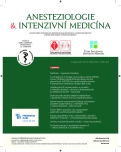Kidney and composition of infusion solutions.
Reason for caution
Authors:
Matějovič Martin
Authors‘ workplace:
I. interní klinika, UK v Praze, LF v Plzni a FN Plzeň
Published in:
Anest. intenziv. Med., 24, 2013, č. 3, s. 183-185
Category:
Special article
Overview
Intravenous fluid therapy is one of the cornerstones of critical illness management. Surprisingly, only very recently findings have suggested that clinicians carefully consider the type, amount and rate of administration of the resuscitation fluids. Indeed, long-awaited studies have been published over the past 12 months, enabling the clinicians to make better decisions which solution to choose from the large menu on offer. This article is a brief commentary on the most recent studies demonstrating the distinct effects of intravenous fluids on the renal physiology and function in critical care and peri-operative medicine.
Keywords:
fluid therapy – critical care – renal physiology – peri-operative medicine
Sources
1. Perner, A. et al. 6S Trial Group, Scandinavian Critical Care Trials Group Hydroxyethyl starch 130/0.42 versus Ringer’s acetate in severe sepsis. N. Engl. J. Med., 2012, 367, 2, p. 124–134.
2. Myburgh, J. A. et al., CHEST Investigators, Australian and New Zealand Intensive Care Society Clinical Trials Group Hydroxyethyl starch or saline for fluid resuscitation in intensive care. N. Engl. J. Med., 2012, 367, 20, p. 1901–1911.
3. Shaw, A. D., Kellum, J. A. The Risk of AKI in Patients Treated with Intravenous Solutions Containing Hydroxyethyl Starch. Clin. J. Am. Soc. Nephrol., 2013 [Epub ahead of print].
4. Antonelli, M., Sandroni, C. Hydroxyethyl starch for intravenous volume replacement: more harm than benefit. JAMA, 2013, 309, 7, p. 723–724.
5. Patel, A., Waheed, U., Brett, S. J. Randomised trials of 6 % tetrastarch (hydroxyethyl starch 130/0.4 or 0.42) for severe sepsis reporting mortality: systematic review and meta-analysis. Intensive Care Med., 2013, [Epub ahead of print].
6. Haase, N., Perner, A., Hennings, L. I., Siegemund, M., Lauridsen, B., Wetterslev, M., Wetterslev, J. Hydroxyethyl starch 130/0.38-0.45 versus crystalloid or albumin in patients with sepsis: systematic review with meta-analysis and trial sequential analysis. BMJ, 2013, 346, p. f839.
7. Zarychanski, R., Abou-Setta, A. M., Turgeon, A. F., Houston, B. L., McIntyre, L., Marshall, J. C., Fergusson, D. A. Association of hydroxyethyl starch administration with mortality and acute kidney injury in critically ill patients requiring volume resuscitation: a systematic review and meta-analysis. JAMA, 2013, 309, 7, p. 678–688.
8. Yunos, N. M., Bellomo, R., Hegarty, C., Story, D., Ho, L., Bailey, M.Association between a chloride-liberal vs chloride-restrictive intravenous fluid administration strategy and kidney injury in critically ill adults. JAMA, 2012, 308, 15, p. 1566–1572.
9. Shaw, A. D., Bagshaw, S. M., Goldstein, S. L., Scherer, L. A., Duan, M., Schermer, C. R., Kellum, J. A. Major complications, mortality, and resource utilization after open abdominal surgery: 0.9% saline compared to Plasma-Lyte. Ann. Surg., 2012, 255, 5, p. 821–829.
10. Wilcox, C. S. Regulation of renal blood flow by plasma chloride. J. Clin. Invest., 1983, 71, p. 726–735.
11. Chowdhury, A. H., Cox, E. F., Francis, S. T., Lobo, D. N. A randomized, controlled, double-blind crossover study on the effects of 2-L infusions of 0.9% saline and plasma-lyte® 148 on renal blood flow velocity and renal cortical tissue perfusion in healthy volunteers. Ann. Surg., 2012, 256, p. 18–24.
Labels
Anaesthesiology, Resuscitation and Inten Intensive Care MedicineArticle was published in
Anaesthesiology and Intensive Care Medicine

2013 Issue 3
Most read in this issue
- N-Terminal-Pro Brain Natriuretic Peptide (NT-pro BNP) and Troponin I as prognostic markers of septic cardiomyopathy
- Current practice in obstetric anaesthesia. Part II General anaesthesia for Caesarean Section
-
Kidney and composition of infusion solutions.
Reason for caution - Papillary muscle rupture in patient with acute myocardial infarction – echocardiographic case report
